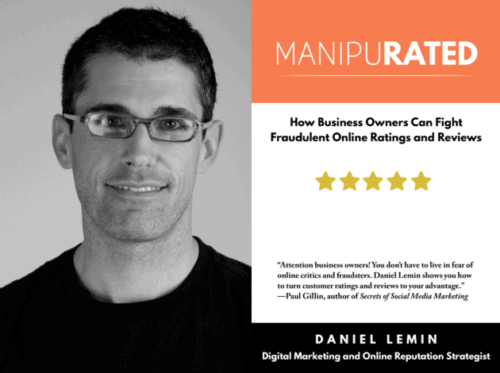#BookClub – Manipurated
The foreword to this book was written by Jay Baer. In it he quotes Nielsen research that claims that 91 percent of Americans trust recommendations from their friends. The fact that I bought the book in the first place proves that…Jay recommended it so I bought.
The book, Manipurated by Daniel Lemin, sheds light on the necessary and often frustrating role that review and ratings sites play in a business’ marketing effort.
I read it on a flight from Phoenix to Puerto Rico so had plenty of time to dive into it. It’s a relatively short read (about 90 minutes including taking notes) and the author provides tips on how to skim the book and find the topics most relevant to the reader so if you don’t want to take the time to read all of it, you can still find it valuable.
According to Lemin (and probably anyone with a customer-facing business) review and ratings sites present a challenge not seen before the Internet age, impacting both your online and on-ground presence. Because potential customers actively seek out this online chatter, it is important for business owners to understand these sites, use them and manage them to your advantage.
In general, the review and ratings sites were created for the consumer, giving them a platform to share the good, the bad and the ugly about their experiences with your business. Think about how often you do a search looking for information on a particular business. Sure you may search the company’s website, but a savvy searcher also clicks on a few postings on the various review sites. The savvy searcher also likely knows that these RSS platforms have no real vetting process for someone to post a review. Sometimes anonymous, sometimes completely fake, these reviews may or may not be trustworthy.
So how does a business gain the upper hand on these various sites? One of my favorite quotes from Jay is something he said in some of his earlier presentations on social media—“if your business stinks, ‘twitter’ is not your problem.” Meaning that the online platform is simply how one person chooses to express his or her feelings about their interaction with your business. But if there is a grain of truth in that negative review, it is time to take a look at your business and see what you can do to make it right.
But assuming that you are a successful business and that the majority of your reviews are positive, how do you continue to use this platform to your business’ advantage? Keeping content on those sites fresh, updated, relevant and engaged. Remind your good customers that a positive review shows their support of your business, don’t be afraid to ask them to consider posting about their experience.
And as the business owner, make a commitment to engage with your reviewers. If you see a posting of a negative experience resist the urge to take it down or work out your differences online. Acknowledge the review, offer an alternative solution. According to Jay’s research into the science of online complaints, less than half of reviewers expect any kind of response so when they actually receive one, the likelihood is that you can turn that negative around.
Some takeaways:
- Rating and Review Sites are among the top sources for new customers. Don’t fear the platform, embrace it.
- Know where your customers come from, pay attention to those reviews.
- The occasional bad review can be good, makes you look legit. And pay attention to what’s been said and respond accordingly.
The majority of our clients are business –to-business so I wasn’t sure how this would apply to the current work that we do. But having a better understanding of these sites, not only from the business perspective but the consumer perspective as well was quite helpful.

